
Chain mail is the name of a type of armour consisting of small metal rings linked together in a pattern to form a mesh. It was in common military use between the 3rd century BC and the 16th century AD in Europe, while continued to be used in Asia, Africa, and the Middle East as late as the 17th century. A coat of this armour is often called a hauberk or sometimes a byrnie.

A scabbard is a sheath for holding a sword, dagger, knife, or similar edged weapons. As well, rifles and other long guns may be stored in a scabbard by horse riders for transportation. Military cavalry and cowboys had scabbards for their saddle ring lever-action carbines and rifles on their horses for transportation and protection. Scabbards have been made of many materials over the millennia, including leather, wood, and metal such as brass or steel.
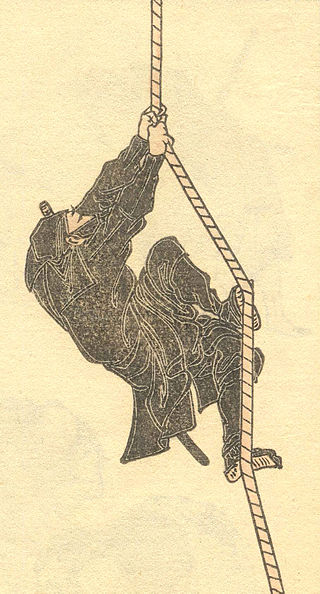
A ninja or shinobi was a covert agent, mercenary, or guerrilla warfare expert in feudal Japan. The functions of a ninja included siege and infiltration, ambush, reconnaissance, espionage, deception, and later bodyguarding and their fighting skills in martial arts, including ninjutsu. Their covert methods of waging irregular warfare were deemed dishonorable and beneath the honor of the samurai. Though shinobi proper, as specially trained warriors, spies, and mercenaries, appeared in the 15th century during the Sengoku period, antecedents may have existed as early as the 12th century.

The nunchaku, "nunchucks", "chainsticks", or "chuka sticks" in English) is a traditional Asian martial arts weapon consisting of two sticks, connected to each other at their ends by a short metal chain or a rope. It is approximately 30 cm (12") (sticks) and 1 inch (rope). A person who has practiced using this weapon is referred to in Japanese as nunchakuka.

A shuriken is a Japanese concealed weapon that was used as a hidden dagger or metsubushi to distract or misdirect.

Dao are single-edged Chinese swords, primarily used for slashing and chopping. They can be straight or curved. The most common form is also known as the Chinese sabre, although those with wider blades are sometimes referred to as Chinese broadswords. In China, the dao is considered one of the four traditional weapons, along with the gun, qiang (spear), and the jian, called in this group "The General of Weapons".

A bō, pong (Korean), pang (Cantonese), bang (Mandarin), or kun (Okinawan) is a staff weapon used in Okinawa. Bō are typically around 1.8 m (71 in) long and used in Okinawan martial arts, while being adopted into Japanese arts such particular bōjutsu. Other staff-related weapons are the jō, which is 1.2 m (47 in) long, and the hanbō, which is 90 cm (35 in) long.

Geta (下駄) are traditional Japanese footwear resembling flip-flops. A kind of sandal, geta have a flat wooden base elevated with up to three "teeth", held on the foot with a fabric thong, which keeps the foot raised above the ground.

A kunai is a Japanese tool thought to be originally derived from the masonry trowel. The two widely recognized kinds are the short kunai and the big kunai. Although a basic tool, the kunai, in the hands of a martial arts expert, could be used as a multi-functional weapon. The kunai is commonly associated with the ninja, who used it to gouge holes in walls.
Visual markers of marital status, as well as social status, may include clothing, hairstyle, accessories, jewelry, tattoos, and other bodily adornments. Visual markers of marital status are particularly important because they indicate that a person should not be approached for flirtation, courtship, or sex. In some cultures, married people enjoy special privileges or are addressed differently by members of the community.
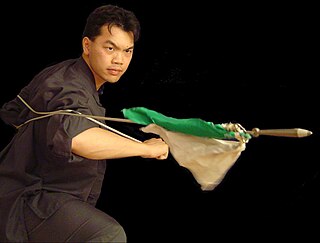
The rope dart or rope javelin, is one of the flexible weapons in Chinese martial arts. Other weapons in this family include the meteor hammer, flying claws, Fei Tou flying weight, and chain whip.

Kusari-fundo is a handheld weapon used in feudal Japan consisting of a length of chain (kusari) with a weight (fundo) attached to each end of the chain. Various sizes and shapes of chain and weight were used as there was no set rule on the construction of these weapons. Other popular names are manrikigusari (萬力鏈) or just manriki.

A thumb ring is a ring meant to be worn on one's thumb. Most commonly, thumb rings are used as an archery equipment designed to protect the thumb pulp from the bowstring during a thumb draw, and are made of leather, stone, horn, wood, bone, antler, ivory, metal, ceramics, plastic or glass. It usually fits over the distal phalanx of the thumb, coming to rest at the distal edge of the interphalangeal joint. Typically a flange extends from the ring to cover the thumb pulp, and may be supplemented by a leather extension.
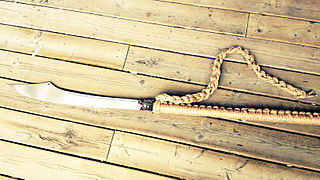
Podao or pudao is a Chinese single-edged infantry weapon that is still used primarily for training in various Chinese martial arts. The blade of the weapon is shaped like a Chinese broadsword, but the weapon has a longer handle, usually around one to two meters which is circular in cross-section. It looks somewhat similar to the guandao.
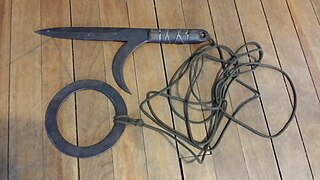
The kyoketsu-shoge is a double-edged blade, with another curved blade attached near the hilt at a 45–60 degree angle. This is attached to approximately 10 to 18 feet (3–5 m) of rope, chain, or hair which then ends in a large metal ring. Likely used by ninja of the Iga province, it is thought to be a forerunner to the later more widely known kusarigama. Ninja were often recruited from the class of rural peasantry who resided on remote farmland, and the tool's resemblance to farming equipment and high versatility in combat gave it many benefits in stealth combat.
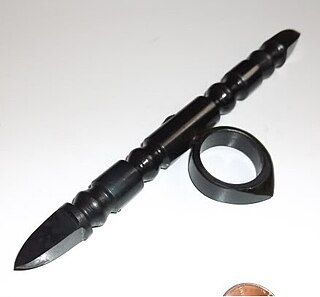
The suntetsu (寸鉄) is a Japanese concealed weapon. A suntetsu is a metal rod/spike about 15 cm (5.9 in) in length with a ring attached to it. The middle finger is inserted into the ring and the suntetsu rests in the hand by various grips. Suntetsu are small, easy to conceal and relatively simple to learn how to use. Suntetsu are used for stabbing, poking, pinching, striking, smashing, scraping and throwing. Suntetsu can be used alone or as a pair.

Emeici are a traditional Chinese martial arts weapon. They are a pair of metal rods with sharp ends used for stabbing; they are typically mounted on a detachable ring worn on the middle finger, allowing them to spin and be elaborately manipulated.
Togakure-ryū (戸隠流) is a historical tradition of ninjutsu known as the "School of the Hidden Door", allegedly founded during the Oho period (1161–1162) by Daisuke Nishina (仁科大助), who learned his original fighting techniques from a Chinese monk named Kain Dōshi. However, the history and early lineage of Togakure-ryū may be impossible to verify due to the antiquity of the time period and its claimed historicity has been disputed by Watatani Kiyoshi, writer for the Bugei Ryūha Daijiten. After Togakure, the title of Sōke was recorded by Toda Shinryuken Masamitsu to have been passed down through other practitioners that kept the style secret from the outside world.

The three-section staff, three-part staff, triple staff, originally sanjiegun or sansetsukon, three-section whip, originally sanjiebian, is a Chinese flail weapon that consists of three wooden or metal staffs connected by metal rings or rope. The weapon is also known as the coiling dragon staff, originally panlong gun. A more complicated version of the two section staff, the staves can be spun to gather momentum resulting in a powerful strike, or their articulation can be used to strike over or around a shield or other defense.

Kakute are rings made of iron or steel that were sometimes worn by the ninja, and favored by the kunoichi, having one to four metal spikes protruding from it. The spikes were sometimes dipped in poison. Kakute were usually worn on the middle finger with the spikes hidden inside the hand, and then used to attack when the enemy least expected. The spikes were also excellent for holding onto an opponent, striking across the face, choking, and sometimes climbing as well. Some kakute had a tab with a hole, that was used for hojojutsu techniques. In this sense, the hojo (rope) could not be easily pulled away from the hands of the ninja or kunoichi, since it was tied to the kakute ring on their finger.

















